

 The South African
The South African
All photographs are from the writer's collection.
This article is published in two parts. The second and concluding part of this article will appear in the next issue of Military History Journal, Volume 16 No 3, June 2013, along with the full bibliography and an appendix listing all surviving ordnance, machine guns and gun carriages of the British South Africa Company.
Preface
The December 1967 issue of the Military History Journal, Vol 1 No 1, contained two short articles by E H J Shaw entitled 'Early Rhodesian Military Units' and 'Early Rhodesia's Weapons'. In the following edition of the Journal, Vol 1 No 2, June 1968, the distinguished military historian, Maj G Tylden, expanded on the information Mr Shaw had provided in a contribution entitled 'Further Notes on Early Rhodesian Military Units and Early Rhodesia's Weapons' in which, so far as weapons were concerned, he relied largely upon notes and a letter from Maj J C Jessor-Coope who had served in Rhodesia from as early as 1890. Although early Rhodesian military units and their weapons played an important part in the history of Southern Africa, nothing else on the subject of the weapons of the British South Africa Company has appeared in any authoritative publication known to the writer in the intervening 45 years.
Neither Mr Shaw nor Maj Tylden suggested that their articles were exhaustive; it is intended that what follows, which will relate only to ordnance and machine guns, should be read simply as an addition to what those articles contain and not in any way dismissive of them.
Any research into the military affairs of the British South Africa Company during the period under discussion is bedevilled by a great lack of official archives. For this there are a number of reasons including the destruction of the Company's London offices during the Second World War and the fact that both C J Rhodes and Dr L S Jameson had a very cavalier attitude to record-keeping. Moreover, both Rhodes and Jameson had their own reasons for keeping many of their activities secret, especially where the acquisition of arms was concerned. This lack of official written records has obliged the writer to rely principally on private memoirs and an extensive contemporary photographic record.
In this article the place names used are those that appear in the 19th century sources; the British South Africa Company is referred to throughout as 'the Company' and the following abbreviations are used: cal - calibre, as originally expressed in fractions of an inch; pdr - pounder; RBL - rifled breech-loading; RML - rifled muzzle-loading; and QF - quick-firing.
Introduction
When the Company was created by Royal Letters Patent in October 1889 its administrative character, within its permitted sphere of operations, was evident principally in the provisions of Clause 10 of its Charter, which reads as follows: 'The Company shall to the best of its ability preserve peace and order in such ways and manners as it shall consider necessary and may with that object in mind make ordinances (to be approved by our Secretary of State) and may establish and maintain a force of police'.
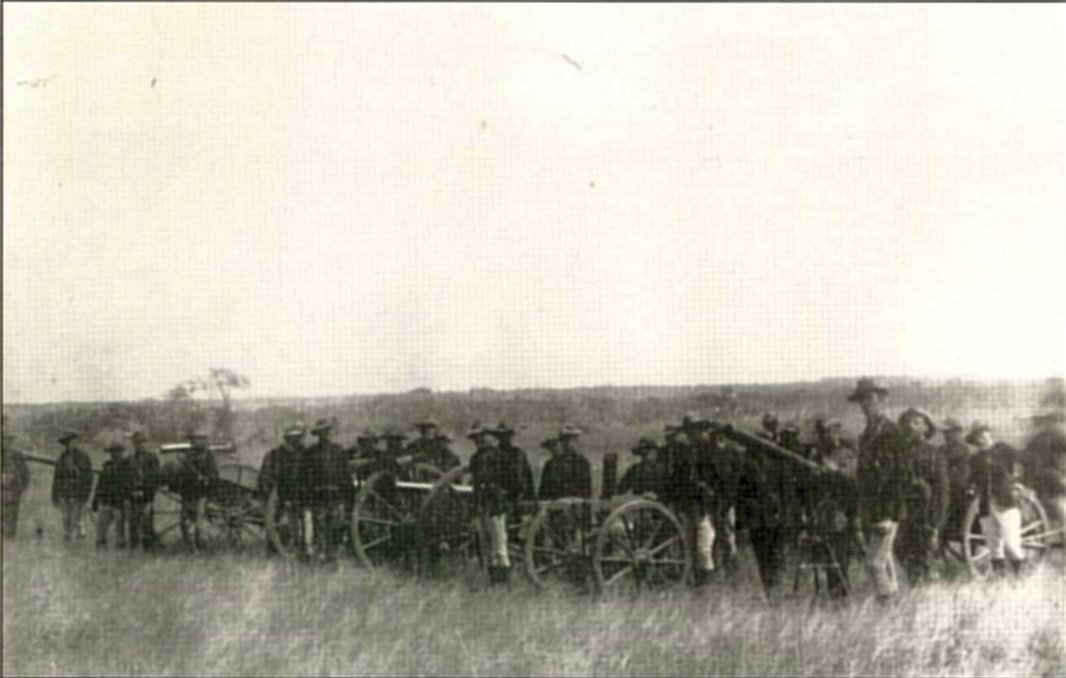
Until 1895, Rhodes, who became Prime Minister of the Government of the Cape Colony in 1890, and was the Company's managing director in Southern Africa with virtually carte blanche to conduct the Company's affairs in the region as he pleased, used the provisions of Clause 10 to authorise the raising of armed forces of police and volunteers. Rhodes and Jameson, who was appointed as the Company's chief official in Mashonaland in 1891, were never too concerned to restrict the use of the Company's armed forces to the preservation of peace and order within the territorial limits envisaged by the Charter. They not only used those forces to secure and hold control of Mashonaland in 1890 and suppress the Matabele and Mashona Rebellions in 1896-97, but also to drive off rival Boer and Portuguese claimants to Mashonaland in 1891, invade Matabeleland in 1893 and attempt to overthrow the government of the Zuid-Afrikaansche Republiek in 189596. The Company's forces that were involved in these conflicts were always well armed with either Martini-Henry, or later, Lee Metford magazine rifles but it was the ordnance and machine guns they possessed that gave them a real sense of invincibility and made major contributions to their greatest military successes.
Rhodes' final plans for the occupation of Mashonaland entailed sending in an armed party of pioneers organised on military lines as the Pioneer Corps. The corps was never actually in the employ of the Company but was raised by F Johnson, who was under contract to the Company to cut a road into Mashonaland and, at its end, to build a fort, Fort Salisbury. There the pioneers would be disbanded to colonise the country. The Pioneer Corps was to be accompanied by three troops of the Company's police (BSAC Police) while two other police troops were to follow in the pioneers' wake. En route the police troops were to establish and garrison three small earthwork forts - Forts Tuli, Victoria and Charter. From these forts the police would guard the lines of communication with the base of operations at the Bechuanaland Border Police post at Fort Matlaputla, which had been constructed at Macloutsie in the north of the Bechuanaland Protectorate.
THE ARMAMENT OF THE COMPANY IN 1890
The Pioneer Corps
Johnson's contract with the Company provided that, apart from small arms, it would lend him the following heavy weapons for issue to the Pioneer Corps: four machine guns, complete with carriages, harness, etc; two 7 pr RML field guns, complete with limbers, carriages, harness, etc; and 20 war rockets with 2 tubes (Johnson, 1940, p 328).
Where the pioneers' artillery and machine guns were to be obtained was not indicated in the contract and some difficulty seems to have been experienced in finding the necessary four machine guns. Johnson himself, writing some 50 years later, recalled that the rear admiral commanding at the Royal Navy's base at Simon's Town supplied him with 'a couple of twenty-four-pounder war rocket tubes, with a supply of rockets ... also a Gatling and a Nordenfelt gun' (Johnson, 1940, p 125).
He added that he never knew 'how Rhodes fixed up this deal' (Johnson, 1940, p 125). As a prominent politician Rhodes could presumably have used his influence to do such a thing and there is no doubt that the naval officer commanding at Simon's Town did make certain arms and equipment available to the Company. However, Johnson's memory of the weapons supplied by the navy cannot be reconciled with photographs of the artillery troop of the Pioneer Corps taken in 1890. These clearly show that troop with two 7 pdr RML field guns, a 0.45 cal Maxim machine gun, a five barrel 0.45 cal Gardner machine gun and two 24 pdr Hale rocket tubes on stands. No Gatling or Nordenfelt machine guns appear in any of the many photographs taken of the Pioneer Corps and it appears that, instead of four machine guns provided for in Johnson's contract, only the Maxim and Gardner guns were issued to the corps.
The Pioneer Corps' 7 pdr RML Field Guns
The Pioneer Corps' two 7 pdrs were 200 Ib RML Mk IV guns. These had initially been introduced into British service in 1873 as mountain and boat guns but the Company's guns were mounted on what was known as the 'Kaffraria' iron'field carriage to suit them for use as light field guns. For draught the carriage was hooked to a limber fitted with ammunition boxes. Being a low velocity, muzzle-loading weapon, loaded separately with the charge in a silk cloth bag followed by the projectile and fired with a friction tube, the gun was obsolete in 1890 for most military purposes. Despite its obsolescence the gun's light weight and mobility made it a useful piece of artillery in difficult country where only ill armed African tribesmen were likely to be encountered. Johnson does not say where the Company found the two 7 pounders his corps received but Tylden produced Jessor-Coope's incontrovertible evidence that he took charge of them for the Company in 1890 from the Bechuanaland Border Police.
In 1890 that police force, which, like the Company's own police, had more of the character of a military unit than a civil one, had a battery that apparently included four 7 pdr RML guns and a 2.5 in RML gun, which had all originally belonged to the Cape Mounted Riflemen. After two of the 7 pdr RML guns had been transferred to the Pioneer Corps it appears that the other three guns remained with the Bechuanaland Border Police at Ft Matlaputla.
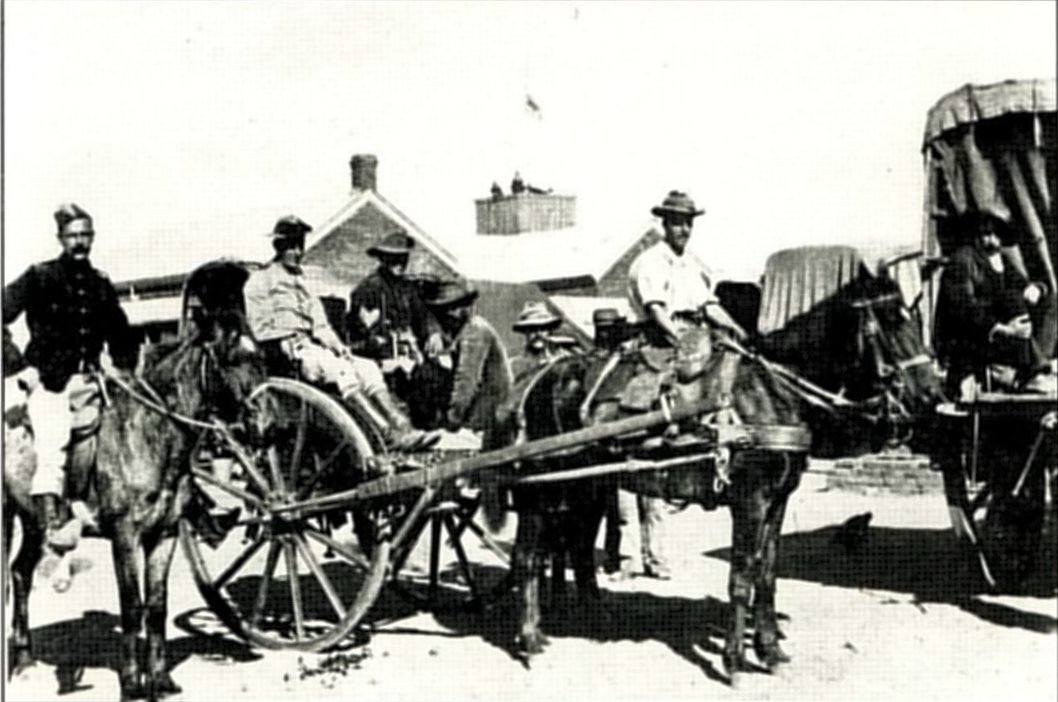
The Pioneer Corps' Maxim Gun
The 0.45 cal Maxim gun was an automatic, trigger-operated, belt-fed weapon that harnessed the recoil effects of the cartridge explosion to continue firing for as long as the trigger lever was depressed and there were cartridges in the belt. It used the Martini-Henry cartridge with a solid drawn case. The mechanism was a highly ingenious but complex one; so complex was the lock itself that it was usual for every gun to be supplied with a spare one as its repair in the field was virtually impossible. The Pioneer Corps' Maxim was mounted on a galloping carriage that was fitted with shafts in which a pair of horses could be harnessed. Unlike the British Army's cavalry and mounted infantry Mk I pattern galloping carriage, to which it was otherwise similar, the type used by the Company had a large shield with a rounded top. Every gun was also provided with a tripod that was carried on the carriage when not in use.
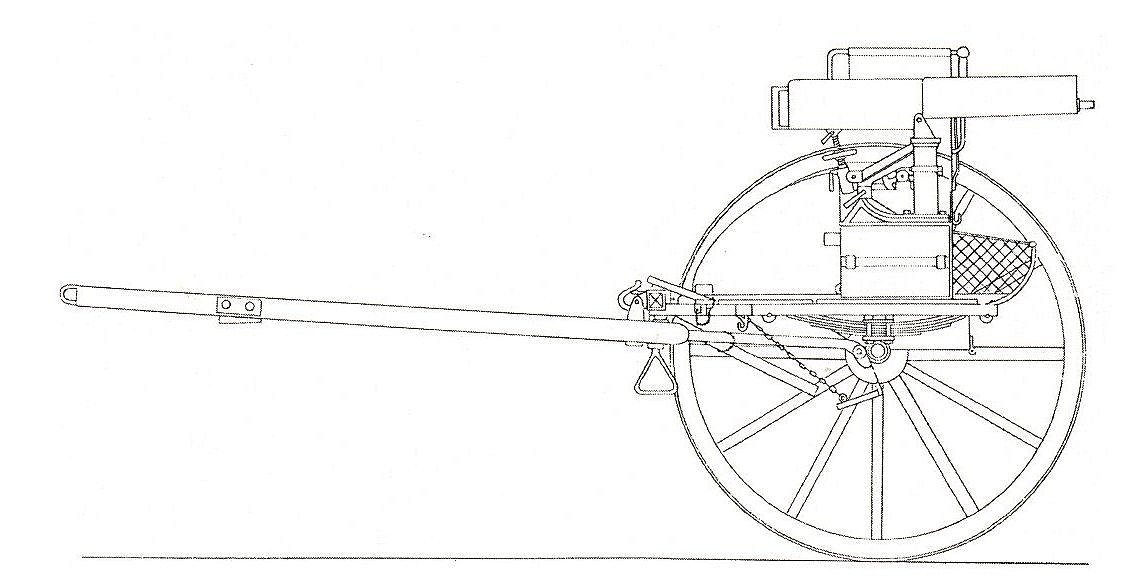
The Pioneer Corps' Gardner Gun
The Gardner gun was a gravity-fed, crank-operated machine gun that was chambered for the Royal Navy's 0.45 cal Gatling/Gardner (GG) cartridge, supplies of which were not easily obtainable other than from the navy. This seems to have militated against the gun's use and it was only ever fired during the Matabele War in 1893 when, it should be said, it caused greater casualties amongst the Matabele at Bembesi than did the Maxims. It was of the same pattern as those used by the Royal Navy in the 1880s and there seems to be no reason to doubt Jessor-Coope's statement, as produced by Tylden, that the gun originally came from HMS Raleigh, then on the Simon's Town station. The gun was mounted on a light iron field carriage that, for draught, was hooked to a small limber fitted with ammunition boxes. The gun had a large rectangular shield that was mounted on the frame holding the barrels; the shield does not appear in photographs taken of the Pioneer Corps but it was fitted for the Matabele War in 1893 and during the Matabele Rebellion in 1896.
The Pioneer Corps' Hale Rockets
Although the 9 pdr rocket had been approved for land service with the British Army, it was the 24 pdr one that was in general use in the Royal Navy, which probably accounts for the fact that the Pioneer Corps had-the latter rocket. The 24 pdr rocket tubes, known officially as rocket machines, were of the 'Fisher' Sea Service Mk II pattern. Nineteenth century war rockets had a controversial reputation in land service and although the Hale rocket was the best of its type, accuracy and reliability were not amongst its qualities. However, it had a reputation, largely unsubstantiated, as a terror weapon when used against 'savage' foes on account of the smoke, flames and awful shrieking that accompanied its flight. Unless stored in very dry conditions the charges of Hale rockets deteriorated rapidly and the rockets became unsafe to use if transported for long distances over rough terrain. It seems likely that the rockets acquired by the Company in 1890 would have been in a dangerous condition within a few years. The tubes themselves are last recorded at the Salisbury laager in 1896. None of the Company's 24 pdr rockets are known to have been used in action.
The 24 pdr Hale rocket was filled with what was known as 'composition', which was a type of black powder made from 70 parts nitre, 16 parts sulphur and 23 parts charcoal that was pressed into the rocket's case to form a solid mass. A conical hole was bored into the base of the composition to assist in its ignition. The rocket was ignited by a friction tube that was pushed into one of the vents. The rockets in service in 1890 had a solid head made in the form of a cast iron shell filled with oak and secured to the case with rivets. The case was made from riveted and brazed sheets of mild steel, had a cast iron base and was painted a dull red. The base was fixed in position with screws and had a tapped central hole into which the cast iron vent piece with three vents, each with an angled vane, was screwed. The pressure of the exhaust fumes on the angled vanes caused the rocket to spin on its axis. The vent piece was protected before use by a screw on metal cap.
The British South Africa Company Police
In 1890 each of the five troops of the BSAC Police had one 0.45 cal Maxim gun on a galloping carriage of the same pattern as that issued to the Pioneer Corps, but there is photographic evidence that, while at Fort Matlaputla, just before moving up into Mashonaland, 'E' Troop, the last to leave the fort, also had a 1 pdr 1.457 cal Maxim-Nordenfelt - later known as a Pom-pom - and a 0.45 cal Gatling machine gun.
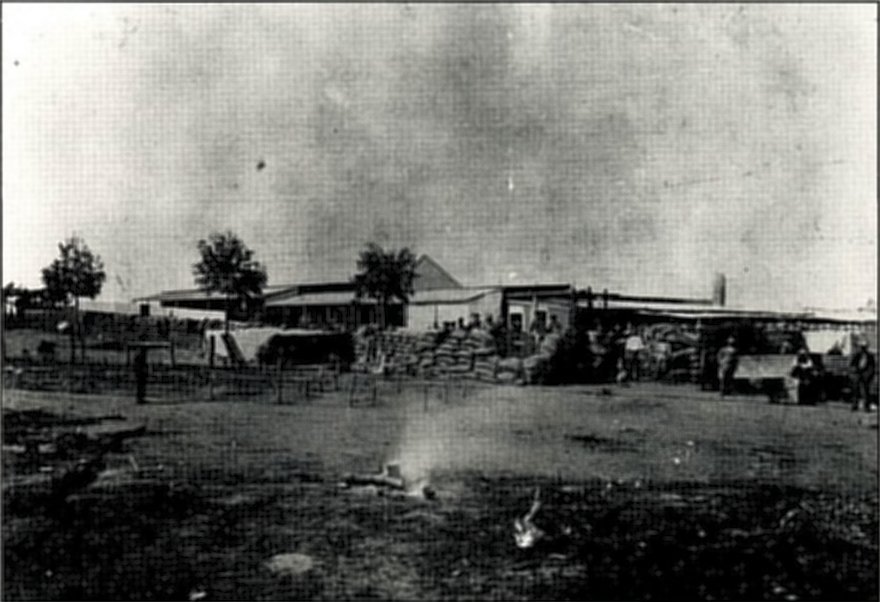
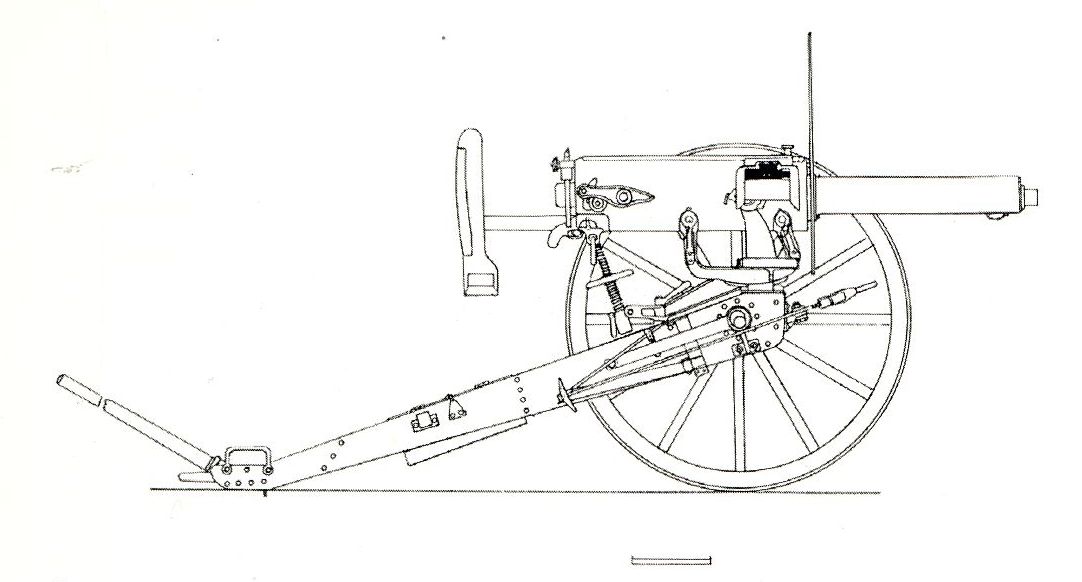
The 1 pdr Maxim-Nordenfelt Gun
The 1 pdr Maxim-Nordenfelt, which used fixed ammunition, was an enlarged version of the Maxim machine gun. It was a heavy weapon that was mounted on a field carriage and required a limber for draught. Its mechanism was essentially the same as that of the rifle calibre Maxim gun. The complexity of its mechanism did not recommend its use to the Company's officers; Maj P Forbes, who was to command the Company's forces in the Matabele War, called it a 'very clumsy gun' (Wills & Colling ridge, 1894, p 66) and declined to take it to Matabeleland. The gun last appears in photographs taken at Salisbury in mid-1896; there is no record of its use in action.
The 0.45 cal Gatling Gun
Strangely, the ten-barrel crank-operated Gatling machine gun was not one of the British patterns adopted for both the army and Royal Navy, but an American-made one. In photographs it looks like a 1883 model that had a distinctive bronze jacket that encased the ten barrels, and a circular Accles magazine. (Slightly modified marks of the 1883 Gatling were produced in 1886, 1887 and 1888 but it is not possible to say which of these the Company had.) It was mounted on a light steel field carriage that required a limber fitted with ammunition boxes for draught; it also had a tripod. The Gatling was chambered for the same 0.45 cal GG ammunition as the Gardner gun and could not use the 0.45 cal Martini-Henry cartridge. The gun last appears in photographs taken at Lobatsi in 1900; there is no record of its use in action.
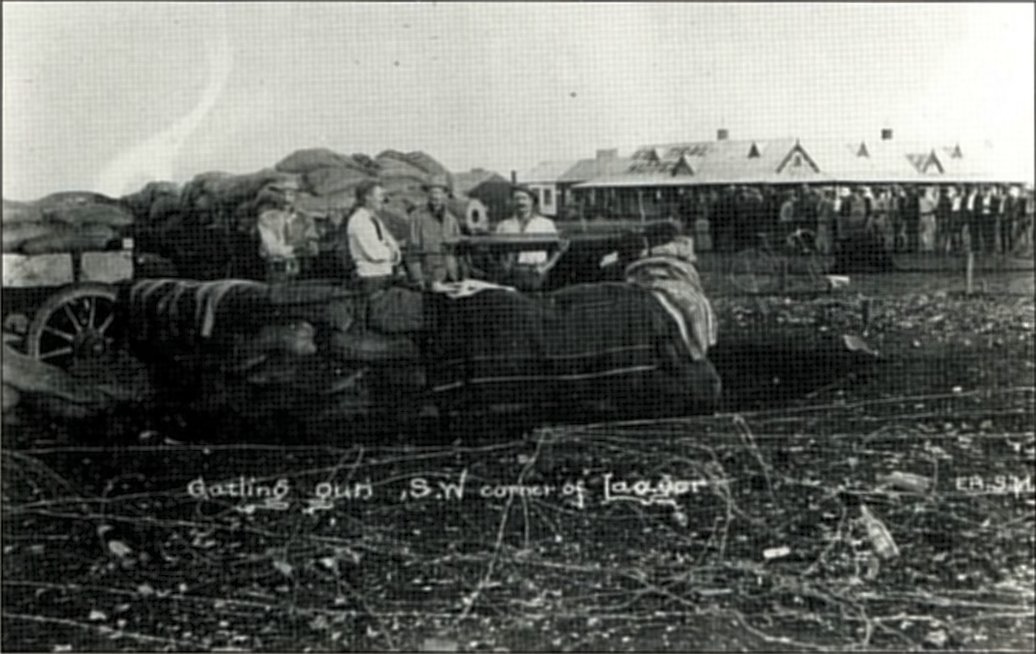
It is possible that the 1 pdr Maxim-Nordenfelt and Gatling gun were the two guns Johnson had in mind when he recorded that the Royal Navy had also provided him with a Gatling and Nordenfelt. However, although they may have been the two machine guns missing from the Pioneer Corps' intended four machine gun armament, perhaps because they were delivered too late to accompany the pioneer column itself, it is most unlikely that either was provided by the Royal Navy as their types were not amongst the navy's service issue weapons in the 19th century. In any event they remained in the hands of the BSAC Police.
ARMAMENTS ACQUIRED BY THE COMPANY IN 1891
By the end of 1890 all the Company's ordnance and machine guns already described, had been moved into Mashonaland and, apart from those left with each of the police garrisons of the three forts along the road, all were handed over to the BSAC Police Artillery Troop at Fort Salisbury. The Company's armament at that time was distributed as follows: two 7 pdr RML field guns at Fort Salisbury; one 1 pdr Maxim-Nordenfelt gun at Fort Salisbury; six 0.45 cal Maxim guns, three at Salisbury and the other thre'e distributed between Fort Tuli and Fort Victoria; one 0.45 cal Gardner gun at Fort Charter; one 0.45 cal Gatling gun at Fort Victoria; and two 24 pdr Hale rocket tubes at Fort Salisbury.
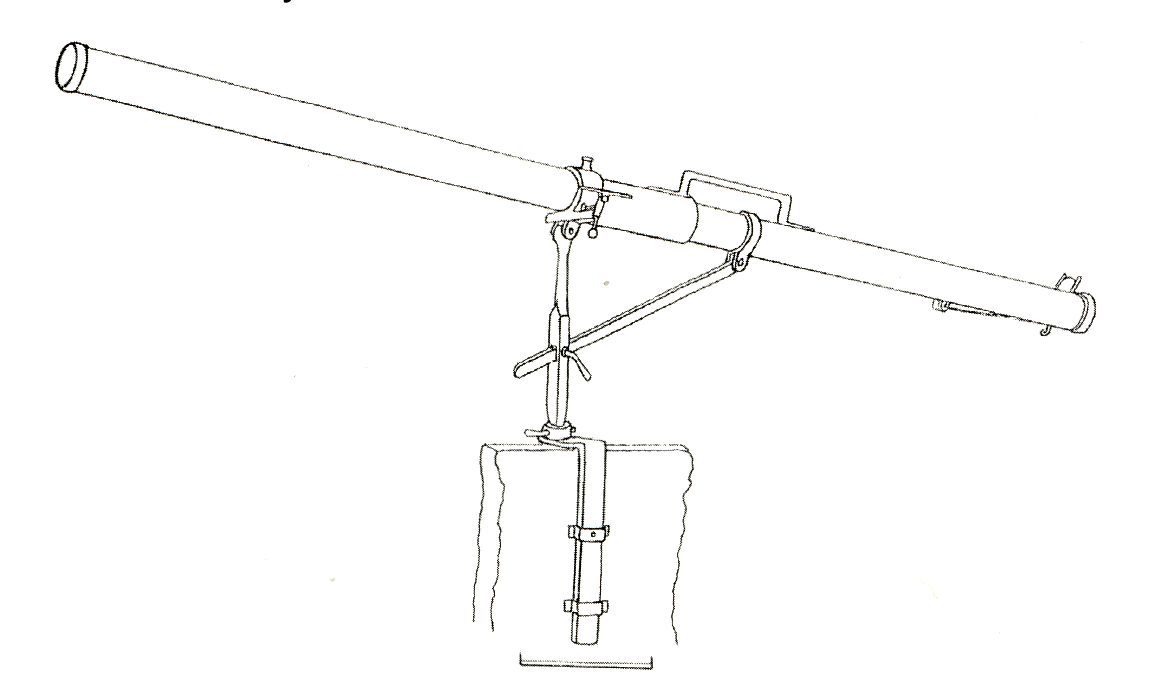
After 1890 there is no official evidence of any further acquisitions of artillery or machine guns by the Company until 1895 but records made in 1893, just before the Matabele War began, indicate that a number of other heavy weapons had come into the Company's possession. These records show that, in addition to the arms listed above, the following were also available for service: one 2.5 in RML gun at Victoria; one 37 mm QF Hotchkiss gun at Salisbury; one 37 mm QF Hotchkiss gun at Victoria; and two 0.45 cal Nordenfelt machine guns at Salisbury.
Photographs taken in 1893 and 1896 establish that the 2.5 in RML gun, which fired a 7 Ib shell and was originally known as a 7 pdr, was a British pattern jointed mountain gun mounted on a mountain carriage. The gun and carriage could be dismantled to allow for their various parts to be loaded on mules, but none of the necessary pack saddles and tools required for that purpose appears to have been available at Victoria in 1893; at that time the gun had to be loaded onto a cart for transport. Photographs also confirm that the Hotchkiss guns were single shot 37mm QF 1 pdrs that had a lever-activated breech block and used fixed ammunition, and that the Nordenfelts were 0.45 cal five barrel, gravity-fed machine guns that were operated manually with a lever. The Hotchkiss and Nordenfelt guns were mounted on light iron or steel field carriages that required limbers for draught but of these latter there were none. Maj P Forbes noted that the Hotchkiss gun and two Nordenfelt guns at Salisbury in 1893 'had been taken from the Portuguese in Manica in 1891' (Wills & Collingridge, 1894, p 66). Capt Donovan (1894, p 185) records that the Hotchkiss gun at Victoria in 1893 'had at one time belonged to the Portuguese'. These plain statements, made some two years after the confrontation with the Portuguese and when happy relations had been restored, belie the confusing accounts of what actually happened in Manicaland in 1891.
On 11 May 1891 a dispute over the border between the territories claimed by the Company and the Portuguese resulted in a skirmish between their troops near Umtali, after which the Portuguese retreated to the coast, leaving their ordnance and machine guns at their fort at Massikessi (now Manica), just below Umtali. Capt H M Heyman, who was in command of the Company's forces at the scene, sent some of his men down to remove any warlike stores and destroy the fort but accounts vary as to what arms they found there and what they did with them.
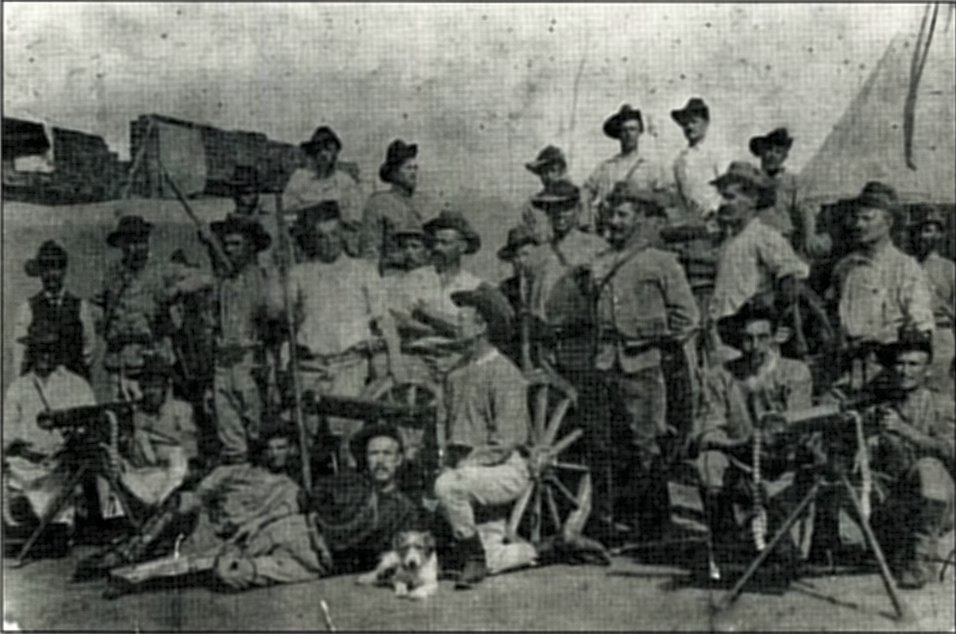
In charge of the party sent down to the fort was Sub Lieutenant V Morier of the BSAC Police. In a letter to his father, Sir Robert Morier, he wrote that he found, in the fort, 'nine machine guns, seven Hotchkiss and two Nordenfelts' (Warhurst, 1965, p 36). Of these eighteen guns, Morier admitted to removing only two Nordenfelts; he wrote that, having 'absolutely destroyed the Hotchkiss' (Warhurst, 1965, p 36), he had dragged the two Nordenfelt machine guns back to the police camp. He said nothing of what happened to the other nine machine guns, nor did he mention a 2.5 in RML mountain gun. (Morier died in 1892, apparently without ever having elaborated on his original record as to what happened at Massikessi.) Other records appear to contradict him. Late in 1891 J T Bent (1896) saw the nine unidentified guns at the police camp at Umtali and recorded that these had been taken from the Portuguese. They were apparently machine guns because he said they were useless on account of the 'pins' having been removed before capture.
The usually reliable and well informed W H Brown recorded that the Portuguese at Massikessi had been armed with 'eleven of the best modern machine-guns' (Brown, 1899, p 166).He added that al.1 of these had been removed from the fort by the police; his eleven guns appear to account for the nine unidentified guns Bent saw and the two Nordenfelts that Morier admits he removed. Brown said nothing about the 2.5 in RML mountain gun or the Hotchkiss guns.
In an archival document, A Tulloch, who had gone down to the fort with Morier, later recorded that only the two Nordenfelts and one Hotchkiss were removed because the other six Hotchkiss guns had been damaged and could not all be dragged back to Umtali; he did not mention the nine unidentified machine guns or a 2.5 in RML gun.
Although the 2.5 in RML gun was not mentioned by Morier or anybody else at the time, F W Burnham's autobiography, published in 1927, contains a photograph of a 2.5 in RMLjointed mountain gun that he identifies as 'the famous seven pounder which was captured at Massikessi' (Burnham, 1927, fp 146). Burnham is notoriously unreliable in his accounts of his own experiences in Matabeleland in 1893 and 1896 but he was not at Massikessi in 1891 and had no reason to be untruthful on this matter; he appears to have assumed that the gun's origins were common knowledge at the time he was writing. Donovan's memoirs confirm that a 2.5 in RML gun was at Victoria in 1893 and was used in the Matabele War; it was later to be used in the Matabele Rebellion. (Its mountain carriage, seen by the writer in 1974, has a number of features that distinguish it markedly from the mountain carriage approved for use by the Royal Artillery with the 2.5 in RML gun.)
There is no doubt that the accounts of Morier, Brown and Tulloch are not full because there is sufficient other evidence to conclude that the 2.5 in RML gun, two Hotchkiss guns and two Nordenfelts must all have been removed from the Portuguese fort in 1891. In addition it appears that probably five, rather than six, of seven Hotchkiss guns found at the fort, were rendered inoperable there and that nine unidentified and unserviceable machine guns were also removed. There is no evidence that any of the disabled guns were capable of being put in working order since none are included in later accounts of weapons available for use by the Company's forces.
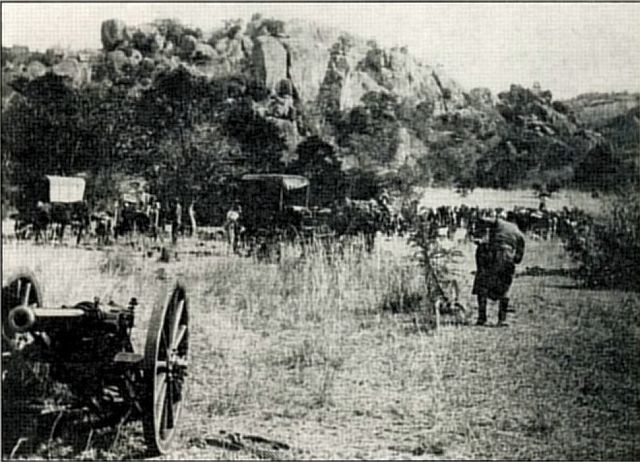
It is not insignificant that, of all the weapons found at the Portuguese fort, the contemporary records are mostly silent, or misleading, on the issue of the removal of the three heaviest ones, namely the 2.5 in RML gun and two Hotchkiss guns. This was probably attributable to the fact that the Company's hold on Manicaland had been secured without any clarity as to the justification of its action in international law; Morier, who was an able and intelligent man, rightly believed that the scene of the conflict had been recognised by the British government as being inside the Portuguese sphere of influence. The Company, if pressed, may have been willing to return the nine unusable machine guns and two Nordenfelts, but giving up the 2.5 in RML gun and two Hotchkiss guns would have been altogether another matter. It seems likely that the Company's senior officials believed that if the Company was to be able to keep these three pieces of ordnance, especially if pedantic British government ministers intervened, it would be as well if their origin could not be traced. This may be the reason for the differences in the original reports as to what guns were found at the fort and how many of them were taken by the Company.

The Portuguese had been obliged to portage all their ordnance and machine guns from the coast to Massikessi, which explains why none of the Hotchkiss and Nordenfelt guns taken by the Company had limbers or, in the case of the 2.5 in RML gun, pack saddles. (In 1896 at Bulawayo, the Gatling limber was pressed into service with one of the Hotchkiss guns.)
Of the Company's weapons available in Mashonaland for service in the Matabele War, only the following were used: one 'Portuguese' 2.5 in RML gun; one 7 pdr RML gun; one 'Portuguese' 37mm Hotchkiss gun; one 0.45 cal 'Portuguese' Nordenfelt gun; one 0.45 cal Gardner gun; and five 0.45 cal Maxim guns.
At the conclusion of the war the Company's arms used in the conflict were initially stared at Bulawayo but all of the Maxims appear to have been returned to Salisbury and Fort Victoria in 1894 or 1895. The Gatling gun was transferred to Bulawayo from Victoria sometime before 1896; it and the 2.5 in RML gun, 7 pdr RML gun, Hotchkiss gun, Nordenfelt and Gardner guns used in the war were still at Bulawayo in 1896.
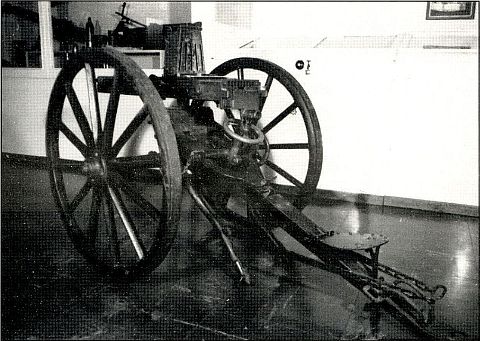
SELECT BIBLIOGRAPHY
Bent, J T, The Ruined Cities of Mashonaland (London, Longmans, Green & Co,1896).
Brown, W H, On the South African Frontier (London, Sampson Low, Marston & Co,1899).
Burnham, F R, Scouting on Two Continents (New York, Doubleday, Page & Co,1927).
Donovan, Capt C H W, With Wilson in Matabeleland (London, Henry & Co, 1894).
Johnson, Lt Col F, Great Days (London, G Bell & Sons Ltd,1940).
Shaw, E H J, 'Early Rhodesia's Weapons' in Military History Journal, Vol 1 No 1, Dec 1967, P 31.
Tulloch A, 'Reminiscences' in Zimbabwe Archives, Ref 1/1/1.
Tylden, Maj G, 'Further Notes on Early Rhodesian Military Units and Early Rhodesia's Weapons' in Military History Journal, Vol 1 No 2, June 1968, p 35.
Warhurst, P R, 'Extracts from the Letters and Diaries of Victor Marier' in Rhodesiana N013, Dec 1965, p1.
Wills, W A & Collingridge, L T, The Downfall of Lobengula (London, The African Review, 1894).
Return to Journal Index OR Society's Home page
South African Military History Society / scribe@samilitaryhistory.org